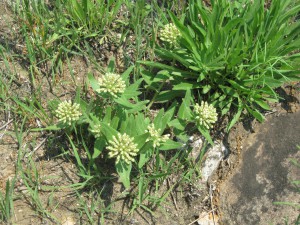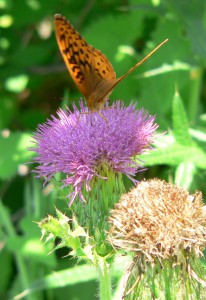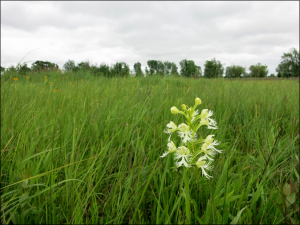Rare Species
The Anna Karenina principle states that “Happy families are all alike; every unhappy family is unhappy in its own way”
When we talk about rare species we tend to think of them as a collective group that shares similar traits, however, I would argue that “every rare species is rare in its own way”. Rabinowitz (1981) showed that all common species had wide ranges, large populations and broad habitat tolerance, while rare species could have any combination of these traits, but not all three. Interestingly, the range, population size and habitat preference all have important consequences for gene flow and population structure.
I am interested in the population genetics of rare species, and what that can tell us about the management of these species.
Species my lab’s research is focused on:
- Asclepias lanuginosa (Wooly milkweed) – rare endemic of shortgrass prairies. Working with Eun Sun Kim (University of Illinois, Chicago, Ph.D, student), Jacob Zeldin (NU MS 2017) and Andrea Kramer (CBG).
- Castilleja affinis subsp neglecta (Tiburon Paintbrush)- This is a rare endemic of Serpentine soils in the Bay Area. Working with Laney Widener (MS 2014) and David Tank at University of Idaho.
- Bessyia bullii (kittentails) – a gravel hill species of Illinois. Working with Andrew Davies (PhD)
- Cirsium pitcheri (Pitcher’s thistle)— rare dune species of great lakes. Working with Kayri Havens (CBG), Pati Vitt (CBG).
- Cirsium hillii (Hill’s thistle) – rare species of gravel hills. Working with Nora Gavin-Smyth (MS Current, NU), Abbey White (MS 2017, NU), Andrea Kramer (CBG) and POC
- Isoëtes butleri (Quillwort)– a rare lycopod of dolomite sites. Working with Erin Vander-Stelt (MS 2015, NU)
- Lepidospartum burgessii – rare gypsophila from New Mexico. Working with Evelyn Webb Williams (Post Doc 2014) and Mike Howard (BLM – New Mexico)
- Oenothera harringtonii – Colorado Endemic. Working with Krissa Skogen (CBG)
- Opuntia fragilis – rare cactus from Illinois.
- Platanthera leucophea – rare orchid from the Midwest. Working with Claire Ellwanger (MS 2017, NU)
- Sclerocactus wrightiae – rare cactus from Capitol Reef. Working with Matt Want (MS Current, NU)
Publications
- Cohen±, DH, JB Fant, KA Skogen (2024) Conservation genomics assessment of Tharp’s bluestar (Amsonia tharpii) with comparisons to widespread (A. longilora) and narrowly endemic (A. fugatei) congeners. Evolutionary Applications 17 (6), e13736
- Ellwanger, Claire+, Laura Steger, Cathy Pollack, Rachel Wells#, and J.B. Fant. 2022. “Anthropogenic Fragmentation Increases Risk of Genetic Decline in the Threatened Orchid Platanthera Leucophaea.” Ecology and Evolution 12 (2): 1–19. https://doi.org/10.1002/ece3.8578.
- Gavin-Smyth, Nora++, Andrea T. Kramer, Rafael Urbina‐Casanova+, Pati L. Vitt, J.B. Fant, Rafael Urbina-Casanova, Pati L. Vitt, et al. 2021. “Genetic Rescue Reduces Mate Limitation in a Threatened, Clonal, and Self-Incompatible Plant Species.” Restoration Ecology 29 (8): e13458. https://doi.org/10.1111/rec.13458.
- Spence, Emma Suzuki, J.B. Fant, Oliver Gailing, M. Patrick Griffith, Kayri Havens, Andrew L Hipp, Priyanka Kadav, et al. 2021. “Comparing Genetic Diversity in Three Threatened Oaks.” Forests 12 (561): 1–18. https://doi.org/10.3390/f12050561.
- Widener, L.++, & J.B. Fant (2018) Genetic differentiation and diversity of two sympatric subspecies of Castilleja affinis; a comparison between the endangered serpentine endemic (spp. neglecta) and its widespread congener (ssp. affinis) Conserv Genet 19 (2) 365-381
- Vander Stelt, Erin++, Jeremie B. Fant, Susanne Masi and Daniel J. Larkin (2017) Assessing habitat requirements and genetic status of a rare ephemeral wetland plant species, Isoëtes butleri Engelm. Aquatic Botany 138; Pages 74-81
- Fant, J.B. , K. Havens, A.T. Kramer, S.K. Walsh, T. Callicrate, R.C. Lacy, M. Maunder, A. Hird Meyer, and P.P. Smith (2016) What to do when we can’t bank on seeds: What botanic gardens can learn from the zoo community about conserving plants in living collections American Journal of Botany (Accepted)
- Williams, E.W. ±, R. Cheung*, C. Siegel*, M. Howard, J. Fant, K. Havens (2016) Persistence of the gypsophile Lepidospartum burgessii (Asteraceae) through clonal growth and limited gene flow. Conservation Genetics; 17 (5) pp 1201–1211
- Kim, E.S. ++, D.N. Zaya+, J.B. Fant and M.V. Ashley (2015) Genetic factors accelerate demographic decline in rare Asclepias species. Conservation Genetics 16(2) 359-369
- Fant, J.B., K. Havens, J.M. Keller#, A. Radosavljevic+ and E.D. Yates and K. Havens (2014) The influence of contemporary and historic landscape features on the genetic structure of the sand dune endemic, Cirsium pitcheri (Asteraceae). Heredity 112, 519–530
- Ribbens E., B.A Anderson., and J. Fant (2011) Opuntia fragilis (Nuttall) Haworth in Illinois: Pad Dynamics and Sexual Reproduction Haseltonia, 16(1):67-78. 2011.
- Fant, J.B., Susanne Masi, J.M. Keller, and R. Mann* (2007) Investigating the reproductive health of Hill’s thistle (Cirsium hillii) populations in the Chicago Region. Chicago Wilderness Journal 5(1).


